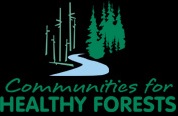
Communities for Healthy ForestsWildfires are burning hotter and bigger than ever before. It’s not a sentiment that’s exactly new, we’ve heard it several times before. But analysis of recent fires across the Western United States is showing scientists that this year’s forest fires raised the stakes yet again.
But why are wildfires increasing in size and temperature? And what makes scientists so sure that the trend is poised to continue?
The article Hotter & Bigger, by Rocky Barker of the Idaho Statesman, does an excellent job in explaining the causes and effects of more intense fire seasons. Here are a few of the issues Barker discusses in his exposé:
Climate change is a contributing factor to more intense fire seasons. Warmer winters mean less snow, which melts sooner and decreases runoff. As a result the forests dry out earlier prompting fire seasons that start earlier and last much longer.
After fires, forests are not getting the chance to recover. Forest fires are becoming so frequent and repeated burns are so hot that the many trees aren’t getting the opportunity to grow big enough to produce seeds. Even in forests with mature tree populations, the dry conditions, invasive brush and damaged soil caused by previous fires discourages their new seeds from germinating on the forest floor.
Hotter and bigger fires burning through dry forests create heat levels that can exceed 1,000 degrees, literally turning the soils to ash and rocks. Ordinarily fallen trees and logs lying on the ground take a very long time to dry out. But seeing ghost trees completely destroyed to the point that nothing but ash remains indicates new realities about wildfire behavior. Fires have adapted with warmer, drier conditions. As a result, we need to adapt our understanding about how wildfires work and our forest practices to manage and fight them.
At Communities for Healthy Forests, we believe this means taking steps to help reduce the risk of wildfire and limit the amounts of excess fuels. Proper land management techniques, backed by revised government policies is the best way to assure that as nature evolves, so does our approach to combating the increased risk of wildfire.
Disclaimer: Articles featured on Oregon Report are the creation, responsibility and opinion of the authoring individual or organization which is featured at the top of every article.


